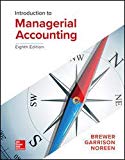
Concept explainers
Applying
Lane Company manufactures a single product and applies overhead cost to that product using standard direct labor-hours. The budgeted variable manufacturing overhead is S2 per direct labor-hour and the budgeted fixed manufacturing overhead is S480.000 per year.
The standard quantity of materials is 3 pounds per unit and the
The company planned to operate at a denominator activity level of 60,000 direct labor-hours and to produce 40,000 units of product during the most recent year. Actual activity and costs for the year were as follows:

Required:
1. Compute the predetermined overhead rate for the year. Break the rate down into variable and fixed elements.
2. Prepare a standard cost card for the company's product; show the details for all
3. Do the following:
a. Compute the standard direct labor-hours allowed for the years production.
b. Complete the following Manufacturing Overhead T-account for the year:

4. Deteimine the reason for any underapplied or overapplied overhead for the year by computing the variable overhead
rate and efficiency variances and the fixed overhead btidget and volume variances.
5, Suppose the company had chosen 65,000 direct labor-hours as the denominator activity rather than 60.000 hours, State
which, if any, of the variances computed in (4) above would have changed, and explain how the variance(s) would have changed. No computations are necessary.
Want to see the full answer?
Check out a sample textbook solution
Chapter 9 Solutions
GEN COMBO LOOSELEAF INTRODUCTION TO MANAGERIAL ACCOUNTING; CONNECT AC
- I am looking for the correct answer to this general accounting question with appropriate explanations.arrow_forwardPlease explain the correct approach for solving this financial accounting question.arrow_forwardCan you explain the correct methodology to solve this general accounting problem?arrow_forward
- I need help finding the accurate solution to this general accounting problem with valid methods.arrow_forwardI am searching for the accurate solution to this general accounting problem with the right approach.arrow_forwardI need assistance with this financial accounting question using appropriate principles.arrow_forward
- I need help with this general accounting question using the proper accounting approach.arrow_forwardI am looking for the correct answer to this general accounting question with appropriate explanations.arrow_forwardPlease provide the correct answer to this general accounting problem using accurate calculations.arrow_forward
- Please provide the accurate answer to this general accounting problem using valid techniques.arrow_forwardPlease provide the solution to this financial accounting question using proper accounting principles.arrow_forwardI need help solving this general accounting question with the proper methodology.arrow_forward
 Managerial Accounting: The Cornerstone of Busines...AccountingISBN:9781337115773Author:Maryanne M. Mowen, Don R. Hansen, Dan L. HeitgerPublisher:Cengage Learning
Managerial Accounting: The Cornerstone of Busines...AccountingISBN:9781337115773Author:Maryanne M. Mowen, Don R. Hansen, Dan L. HeitgerPublisher:Cengage Learning Principles of Cost AccountingAccountingISBN:9781305087408Author:Edward J. Vanderbeck, Maria R. MitchellPublisher:Cengage Learning
Principles of Cost AccountingAccountingISBN:9781305087408Author:Edward J. Vanderbeck, Maria R. MitchellPublisher:Cengage Learning Managerial AccountingAccountingISBN:9781337912020Author:Carl Warren, Ph.d. Cma William B. TaylerPublisher:South-Western College Pub
Managerial AccountingAccountingISBN:9781337912020Author:Carl Warren, Ph.d. Cma William B. TaylerPublisher:South-Western College Pub Financial And Managerial AccountingAccountingISBN:9781337902663Author:WARREN, Carl S.Publisher:Cengage Learning,
Financial And Managerial AccountingAccountingISBN:9781337902663Author:WARREN, Carl S.Publisher:Cengage Learning, Cornerstones of Cost Management (Cornerstones Ser...AccountingISBN:9781305970663Author:Don R. Hansen, Maryanne M. MowenPublisher:Cengage LearningPrinciples of Accounting Volume 2AccountingISBN:9781947172609Author:OpenStaxPublisher:OpenStax College
Cornerstones of Cost Management (Cornerstones Ser...AccountingISBN:9781305970663Author:Don R. Hansen, Maryanne M. MowenPublisher:Cengage LearningPrinciples of Accounting Volume 2AccountingISBN:9781947172609Author:OpenStaxPublisher:OpenStax College





